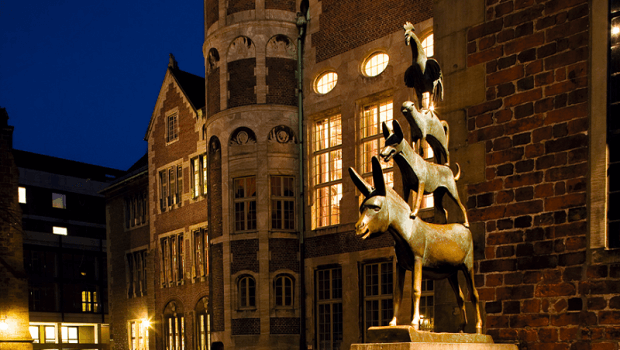
Bremer Stadtmusikanten: A Story for one and All
Bremer Stadtmusikanten or the Town Musicians of Bremen is a part of the Grimm fairy tales created by the Brothers Grimm. The main characters of the story are: rooster, cat, dog and donkey and it is about their journey towards the liberal city of Bremen.
Bremen, the Hanseatic City
It is located in the north western side of Germany and is where you will find numerous UNESCO World Heritage sites along with the Bremer Stadtmusikanten or the Bremen Town Musicians. The city by its very design is rich in myriads of facets that range from the historical to the traditional and are high in technology at the same time speak volumes about the German way of living. It is a spectacular city with respect to all the high Germanic standards. It is cosmopolitan having a historical milieu that is spread across 1200 years.
The city houses some of the most amazing buildings that had once been operational as a part of a trading centre. Additionally, there are so many monuments, that a lifetime seems less when it comes to exploring all of them. Among them is the Town Hall which was built during the time of German Renaissance. The statue of Roland is another such monument. It is located on the market square which again is historically significant. Both these structures together are listed in the UNESCO World Heritage forum. Also, more importantly, they have been symbolically representing the spirit of independence since the year 1404. The city and its structures project a certain kind of charm that is simply un-paralled.
The Bremer Stadtmusikanten or the Bremen Town Musicians is how the world knows about the city of Bremen. Interestingly enough, in the fairy tale itself no body reaches the town of Bremen. The four main characters of the tale can be seen if you travel towards the Gerhard Marcks. Also, one does get more opportunities to meet with the characters otherwise. For instance, they can be marvelled at the arty courtyards that are further located in the allies of Böttcherstraße. These figures and the city, together recount the events of the bygone age thorough narratives, life like images in an open air arena on every Sunday sharp at 12 noon. You would also appreciate the spirit of the city because they conduct the various performances without charging a single penny.
Bremer Stadtmusikanten: Its plot
The main characters of this fairy tale are: a donkey, a dog, a cat, and a rooster or a hen. These characters are shown to be past their prime years and them living their lives in their respective farms. However, the context is portrayed to be slightly grim as in the story they are meant to be cast-off or abused at the hands of their masters. Furthermore, as the story develops, these characters leave their homes and set out together on a journey and it is this journey that leads to the city of Bremen. The city of Bremen in the story is presented as the land of freedom wherein each and every individual or creature gets a fair chance at life. Therefore, the four of them decide to reach the city and become musicians. One of the most intriguing lines of the story goes like this: “Something better than death we can find anywhere.” This statement is simply descriptive of the pain that is a result of the loss of liberty.
While the donkey, the dog, the cat, and the rooster are on the route to Bremen they witness a well-lit cottage. They get curious and decide to pry. On the inside the cottage seems quite classy and occupied by four robbers who are shown as individuals who have amassed a great deal of wealth and are living their lives to the fullest. Now, the four main characters of the story all this while are shown to be standing on each other’s back while looking through the window. Almost instantly they decide to scare the robbers and thus begin to make loud scary sounds. Hearing the noise the robbers get afraid and immediately run out of the house with tales between their legs. The four characters then go on and take charge of the house. When the chaos settled they prepared a good meal and decided to stay in for the evening.
Interestingly, as the night settled in the robbers returned. Still a bit shaky, they asked one of them to go inside their cottage and enquire if it is safe or not. One of them then went inside while taking a candle so that he could see better and be sure of the surroundings. Moreover, the events that preceded his entry into the cottage happen in a matter of seconds. What had happened was that the cat pounced upon the sole robber and profusely scratched his face. The dog on the other hand bit him on one of his legs and the donkey kicked him. Finally, the hooves and the rooster chased the robber out of the door through their crows. Upon seeing their fellow hastily approaching them, the robbers stood still in paranoia. The robber, who returned, narrated the entire tale with a certain twist. In his version he was scratched by the long fingernails of a witch, an ogre had knifed him, a giant hit him with his club and finally, a judge screamed at him by sitting on the rooftop. Together in their bafflement, they concluded that the cottage has been bewitched and abandoned the cottage. As a result the animals lived happily ever after in the cottage for the rest of their days.
There is an alternate version to this story as well in which the original masters of these animals lived in utter depravity because the thieves had stolen all their belongings or had destroyed the respective farms of these owners. It is due to this reason that the owners were no longer capable of taking care of the animals that they had to let them go. Now, in this version the thieves take whatever they had stolen to their master so that he could then rebuild his own abode. Furthermore, there are other versions to this story wherein sometimes a wild animal or an animal belonging to the non-livestock category, such as, a lizard assist the animals in dispatching the thieves.
The various adaptations
There have been screen and stage based adaptations of the Bremer Stadtmusikanten or the Town Musicians of Bremen. Following is a list that will give you an idea:
- Die Bremer Stadtmusikanten: This was an operatic adaptation of the Bremer Stadtmusikanten by Richard Mohaupf, a composer of dual, German and U.S heritage. It was premiered in the year 1949 in Bremen.
- Wolves, Witches and Giants: This was one of the later adaptations in the honour of the humorous fashion of the Great Britain by Spike Milligan. This was meant to be a part of a children’s series and the action in this version took place in a fictional place called Brum instead of Bremen. It was in fact a shortened form of Birmingham.
- The New Bremen Musicians: This story was centred in the Soviet Union and was a sequel to the rather loosely adapted animated musical which was conducted in the year 1969 by Yuri Entin and Vasily Livanov. This version was performed in Soyuzmultfilm, a popular regional studio. Its first version was called – The Bremen Town Musicians. Its sequel, The New Bremen Musicians was performed in the year 2000 and was 56 minutes long.
- I Musicanti: The Italian directors – Sergio Bardotti and Luis Enríquez Bacalov in the year 1976 adapted Bremer Stadtmusikanten or the Town Musicians of Bremen as ‘I Musicanti’. About two years later to this adaptation it was translated into Portuguese by one of the most famous Brazilian composers, Chico Buraque. This newer version was called Os Saltimbancos. An album of the same was also released and it became an even greater hit, solidifying its status among the greatest children’s classics of its time in Brazil. On the other hand, in Spain another adaptation was created but this time in the form of an animated film and was titled as: Los Trotamúsicos (1989). It was directed by a certain Cruz Delgado. Inspirations were drawn from these versions and a Spanish animated series was created – Los Trotamúsicos.
- Mini Moni.de Bremen no Ongakutai: This was a Japanese dramatically representation of the original fairy tale wherein the action takes place in the reverse simultaneously covering three of the major periods within the history of Japan.
- The Muppet Musicians of Bremen: In the year 1972 the muppets version of the fairy tale was created by a certain Jim Henson who produced it.
- The Fearless Four or Die furchtlosen Vier: In the year 1997 an animated feature was showcased on the televisions of the United States and Germany. The American version was voiced by some of the biggest names in the industry. Such as, James Ingram who gave voice to the character of Buster the dog, B.B. King – he voiced the character of Fred the donkey, Oleta Adams who was Gwendolyn the cat and finally, Zucchero Fornaciari, he played the role of Tortellini the Rooster.
- Happily Ever After: Fairy Tales for Every Child: The story of Bremer Stadtmusikanten also featured on Cartoon Network as a part of the “Happily Ever After: Fairy Tales for Every Child” series. The Town Musicians of Bremen aired as the third story and was presented with a twist.
